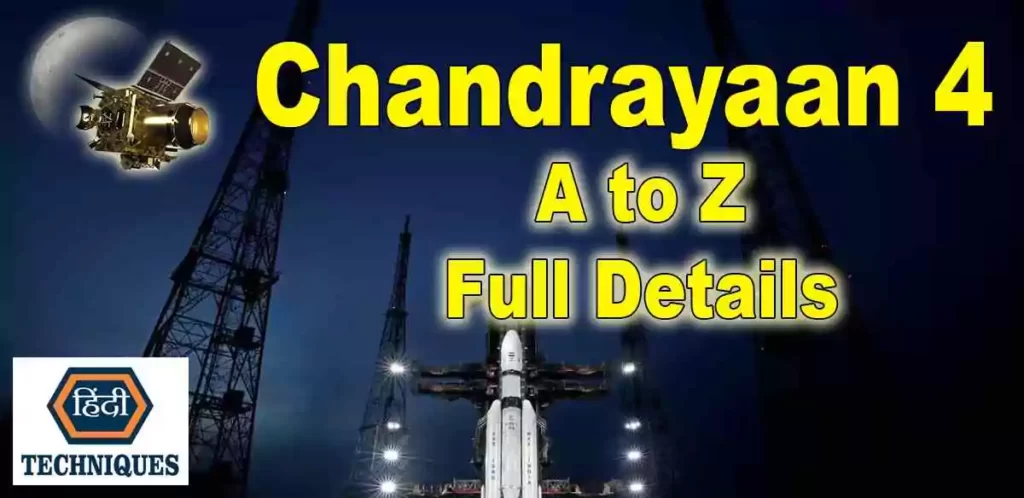Last updated on August 14th, 2024 at 04:02 pm
Chandrayaan 4 launch date and time.Chandrayaan-4 could mark the next chapter in India’s lunar exploration endeavors, building upon the success of its predecessors. This mission would likely aim to delve even deeper into the moon’s mysteries by employing advanced instruments and cutting-edge technologies to study its surface, geology, and mineral composition. One significant aspect of Chandrayaan-4’s planning would be the selection of Chandrayaan 4 launch date and time in India.
Launch windows to the moon are influenced by factors such as the moon’s orbital position, alignment with Earth, and optimal trajectory for reaching lunar targets. These launch windows provide specific timeframes during which spacecraft can be launched most efficiently to reach the moon. Given ISRO’s meticulous planning and precision, the agency would likely aim to capitalize on a favorable launch window to ensure the success of Chandrayaan-4.
What is Chandrayaan 4 Mission?
Chandrayaan 4 is the fourth installment in India’s prestigious Chandrayaan series. It is an ambitious lunar exploration mission that aims to build upon the successes of its predecessors. Chandrayaan 4 is a collaborative effort between the Indian Space Research Organisation (ISRO) and the Japan Aerospace Exploration Agency (JAXA).
The mission, also known as Lunar Polar Exploration (LUPEX), is set to make significant contributions to our understanding of the lunar environment.
Objectives of the Chandrayaan 4 Mission.
The primary objective of the Chandrayaan 4 mission is to assess the lunar polar region for the presence and potential usability of water.
Chandrayaan-4’s mission objectives might include:(Chandrayaan 4 launch date and time)
- Detailed Surface Imaging: Utilizing advanced cameras and imaging instruments to capture high-resolution images of the moon’s surface, enabling scientists to study surface features, geological formations, and potential landing sites for future missions.
- Mineral Composition Analysis: Employing spectrometers to analyze the moon’s mineral composition, identifying various elements and compounds present on its surface. This information could provide insights into the moon’s origin and evolution.
- Geological Studies: Conducting in-depth geological studies to understand the moon’s tectonic history, volcanic activity, and impact cratering processes. These studies could help unravel the moon’s geological timeline.
- Resource Assessment: Examining the moon’s surface for potential resources, including water ice, helium-3, and other valuable materials that could support future lunar missions and exploration.
- Technological Demonstrations: Testing and demonstrating advanced technologies for lunar exploration, navigation, and communication. These demonstrations could pave the way for more sophisticated missions in the future.
Chandrayaan 4 launch date and time

Chandrayaan 4 Launch Date and Time in India.
As of now, specific details regarding the Chandrayaan 4 launch date and time have not been officially announced by the Indian Space Research Organisation (ISRO). But, it is anticipated that the mission will take place in the year 2026. The Chandrayaan 4 mission is a collaborative effort between ISRO and the Japan Aerospace Exploration Agency (JAXA), and both agencies are working diligently to ensure a successful launch.
The exact launch date and time of space missions can be subject to change due to various factors, including technical preparations, weather conditions, and logistical considerations. ISRO typically provides detailed information about the launch schedule closer to the mission’s actual launch date. It’s important to stay updated through official ISRO channels and announcements to get accurate and timely information about the Chandrayaan 4 launch date and time in India.
How is Chandrayaan 4 different from Chandrayaan3?
Chandrayaan 4 follows the successful Chandrayaan 3 mission, which marked India’s entry into soft lunar landing. Chandrayaan 3 aimed to explore the lunar surface’s south pole region, while Chandrayaan 4 shifted its focus towards studying the lunar polar region. This change in focus highlights ISRO’s commitment to comprehensive lunar exploration, targeting different regions and objectives.
Unmanned Mission or Human Presence?
Chandrayaan 4 is planned as an unmanned mission, focusing on data collection and analysis. While ISRO has its eyes set on future human spaceflight missions, Chandrayaan 4’s primary purpose is to gather vital information about lunar water resources and the lunar environment. This data will be invaluable for planning and executing future human missions to the Moon.
Collaborative Efforts with JAXA
Chandrayaan 4 is a collaborative effort between ISRO and JAXA, the space agency of Japan. The joint venture combines the expertise and resources of both nations to achieve the mission’s objectives effectively. This collaboration underscores the global nature of space exploration and the importance of sharing knowledge and technology.
Cost of the Chandrayaan 4 Mission
As of now, the exact cost of the Chandrayaan 4 mission has not been officially disclosed by the Indian Space Research Organisation (ISRO). The cost of space missions can vary based on a range of factors including the complexity of the mission, the technology and instruments involved, research and development expenses, launch vehicle costs, and more.
Previous Chandrayaan missions, such as Chandrayaan 1 and Chandrayaan 2, had estimated costs of around $83 million and $141 million respectively. Chandrayaan 3, which was an orbiter mission designed to study the Moon, had an estimated cost of around $52 million. Given that Chandrayaan 4 is expected to be a more advanced mission with collaboration from the Japan Aerospace Exploration Agency (JAXA), it is likely that the cost will be higher.
Chandrayaan 4 launch date and time

Chandrayaan 4 Kab Launch Hoga?
Chandrayaan 4 ki abhi tak koi official launch date announce nahi hui hai. ISRO (Indian Space Research Organisation) ne is mission ke launch date ke bare mein abhi tak koi vyavasthit ghoshna nahi ki hai. Haalanki, kuch reports ke anusaar, Chandrayaan 4 ki launch ki ummid 2026 mein hai. Ye mission India aur Japan ke collaboration mein ho raha hai aur iska main focus lunar polar region ke exploration par hoga.
Launch date ka tay kiya jaana aage ke mahino mein hoga jab ISRO apne plans ko finalize karega aur mission ke liye taiyaariyan shuru karega. Chandrayaan 4 ke launch date ke liye updated jaankari ke liye ISRO ke official website ya unke pramukh abhigaman sthalon ka upyog kiya ja sakta hai.
Chandrayaan 4 and 5.
As ISRO continues to push the boundaries of lunar exploration, the Chandrayaan series of missions evolves with each new endeavor. Chandrayaan-4 is on the horizon, and its nature as a manned or unmanned mission is a topic of anticipation. It is envisaged that before venturing into human lunar missions, ISRO might utilize Chandrayaan-4 as an intermediate phase, serving as a stepping stone toward more complex objectives.
The prospect of humans setting foot on the moon might materialize with Chandrayaan-5 or subsequent missions. The intricate details of these missions are still taking shape, and the timeline for such ambitious feats will be unveiled as plans solidify. To stay well-informed and up-to-date, relying on trustworthy sources like our blog will ensure you have access to accurate and timely information. As ISRO’s vision unfolds, the Chandrayaan series is set to leave an indelible mark on lunar exploration history.
Technologies and Instruments on Chandrayaan 4
Chandrayaan-4, the upcoming lunar mission by the Indian Space Research Organisation (ISRO), is poised to be equipped with a range of advanced technologies and instruments aimed at unraveling the mysteries of the lunar surface. As part of its scientific and exploratory objectives, the mission is set to carry cutting-edge tools that will facilitate a deeper understanding of the moon’s composition, environment, and potential resources.
Here are some of the key technologies and instruments onboard Chandrayaan-4:
| Payload | Description |
|---|---|
| POLIX (Polarimeter Instrument in X-rays) | X-ray polarimeter to measure the degree and angle of polarization in the 8-30 keV energy range of X-ray photons from celestial sources. |
| XSPECT (X-ray Spectroscopy and Timing) | Provides fast timing and spectroscopic information in the energy range of 0.8-15 keV for various X-ray sources. |
| Integrated Radar Instrument Structure (IRIS) | Houses Synthetic Aperture Radar (SAR) payloads using the Sweep SAR technique for remote sensing. |
| Payload Data Subsystem | Engineering payload responsible for handling and transmitting scientific data. |
| High-rate Science Downlink System | Facilitates high-speed transmission of scientific data from the observatory. |
| GPS Receivers | Provides accurate position and timing information for the mission. |
| Solid State Recorder | Stores and retrieves mission data for further analysis and study. |
These advanced technologies and instruments stand as a testament to India’s commitment to advancing space exploration and expanding our knowledge of the moon’s intricacies.
Founder of Chandrayaan 4
The Chandrayaan series of missions is a collective effort led by the Indian Space Research Organisation (ISRO), and in some cases, international collaboration is also an essential aspect. Chandrayaan missions involve partnerships and collaborations with various space agencies and organizations to enhance the scientific and technological capabilities of the missions. One such collaboration is with the Japan Aerospace Exploration Agency (JAXA).
In the case of Chandrayaan 4, there is a possibility that JAXA, the Japanese space agency, might be included in this mission. Collaborations like these bring together the expertise and resources of multiple countries to achieve common goals in space exploration. JAXA’s involvement could bring valuable contributions to Chandrayaan 4 in terms of technology, instruments, expertise, and resources.
While the specifics of JAXA’s involvement and contributions are yet to be confirmed, the potential partnership showcases the international nature of space exploration and the spirit of cooperation among space agencies. Such collaborations not only enable the sharing of knowledge and expertise but also promote global scientific advancements.
Chandrayaan 4 launch date and time.

ISRO’s next moon mission.
ISRO’s next moon mission is the Chandrayaan 4 mission, which is expected to be a continuation of India’s lunar exploration endeavors. Chandrayaan 4 aims to build upon the successes of previous missions and further advance our understanding of the moon’s surface, geology, and potential resources.
One of the key objectives of Chandrayaan 4 is to assess the presence and potential usability of water resources in the lunar polar region. Water is a critical resource for future lunar exploration and could support sustained human presence on the moon. Chandrayaan 4 will employ various observational techniques, in-situ experiments, and data analysis to determine the quantity and quality of lunar water resources.
As of now, the Chandrayaan 4 mission is in the planning and development stages, and more information about its launch date, objectives, and specific technologies will be revealed as the mission progresses. It’s advisable to stay updated with official ISRO announcements and reliable sources for the latest information on ISRO’s upcoming moon missions.
Conclusion
Chandrayaan 4 is poised to continue India’s legacy of space exploration and technological advancements. As ISRO and JAXA collaborate to launch this mission, the scientific community and space enthusiasts around the world eagerly await the valuable insights that Chandrayaan 4 will provide. With each mission, India moves closer to unraveling the mysteries of the Moon and beyond.
FAQs
Is Chandrayaan 4 a collaborative mission?
Yes, Chandrayaan 4 is a collaborative mission between ISRO and JAXA, combining the expertise of both agencies.
When is the expected launch date of Chandrayaan 4?
While specific details are yet to be announced, Chandrayaan 4 is expected to launch sometime in 2026.




